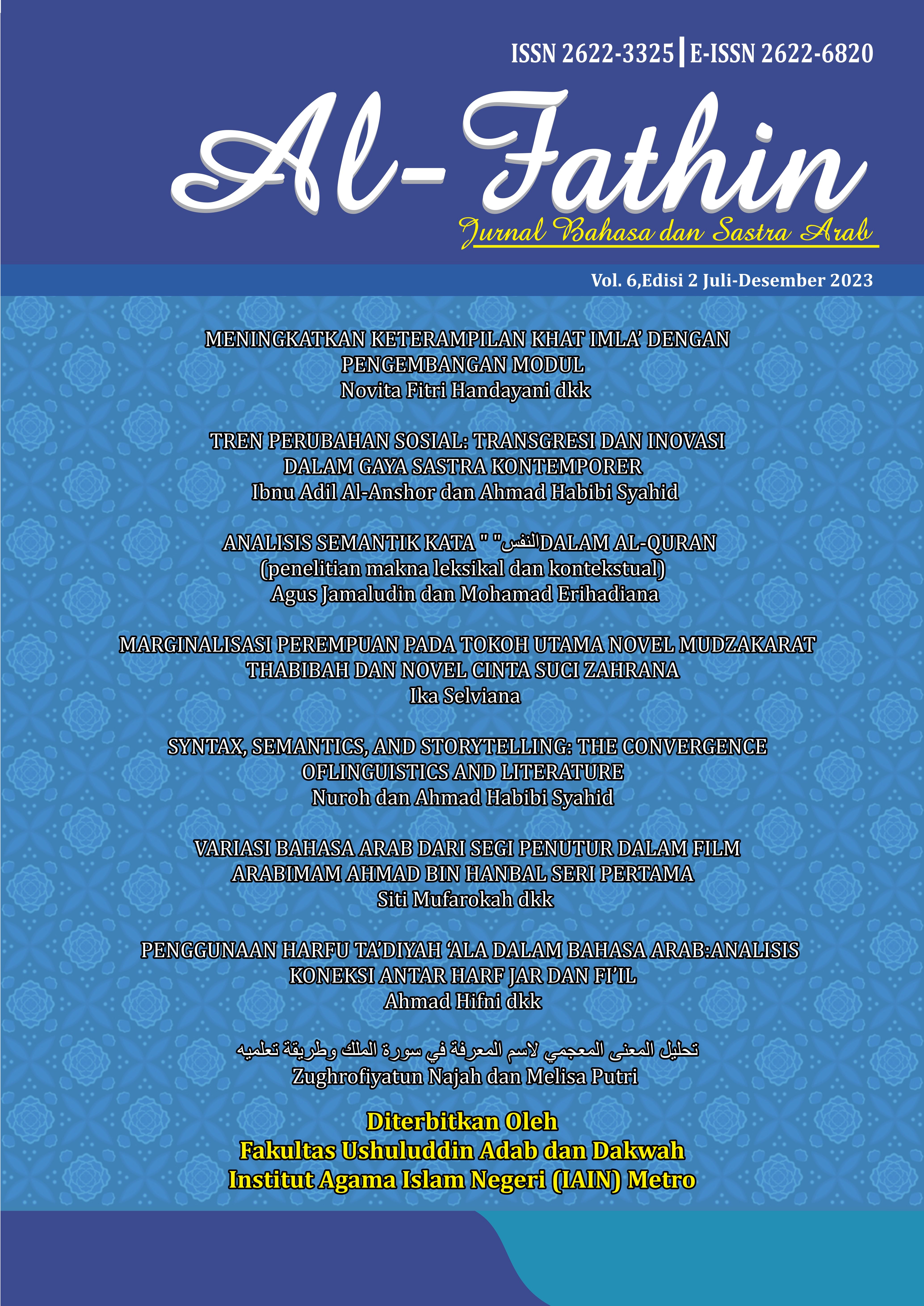Syntax, Semantics, and Storytelling: The Convergence of Linguistics and Literature
DOI:
https://doi.org/10.32332/al-fathin.v6i02.8068Keywords:
syntax, semantics, storytelling, ; linguistic, literatureAbstract
This article discusses the convergence between linguistic and literary studies, especially in the context of syntax and semantics, and how this convergence influences narrative in literary works. Through a multidisciplinary approach, this article explores the ways in which linguistic elements such as sentence structure and the meaning of words can deepen our understanding of stories and characters in literary works. In syntactic analysis, this study explains how sentence structure in literary texts can affect narrative rhythm, express character emotions, and create dramatic tension. On the other hand, semantic analysis reveals how the choice of words and their meanings can design hidden messages in narratives, enrich characterization, and express main themes in literary works. This article also describes how this linguistic approach can help readers and researchers of literature better understand how writers use language to create powerful and diverse works. By considering the essential role of syntax and semantics in literature, this article highlights the importance of integration between linguistic and literary studies in analyzing and appreciating the richness and complexity of literary works, as well as providing a deeper view of how language plays a key role in the process of telling stories and creating meaningful literary experiences. deep.
References
Bobkina, J., & Dominguez, E. (2014). The use of literature and literary texts in the EFL classroom; between consensus and controversy. International Journal of Applied Linguistics and English Literature, 3(2), 248–260. https://doi.org/10.7575/aiac.ijalel.v.3n.2p.248
Darwin, D., Anwar, M., & Munir, M. (2021). Paradigma Strukturalisme Bahasa: Fonologi, Morfologi, Sintaksis, dan Semantik. Jurnal Ilmiah SEMANTIKA, 2(02), 28–40. https://doi.org/10.46772/semantika.v2i02.383
Deyana Chriszia, Suyitno, dan E. S. (2020). Analisis Tokoh Utama Dan Nilai Pendidikan Karakter Dalam Novel Pada Sebuah Kapal Karya N.H. Dini Serta Relevansinya Sebagai Bahan Ajar Di Sma Deyana. Basastra Jurnal Bahasa, Sastra, Dan Pengajarannya, 8(2), 338–346.
Fransori, A. (2017). Analisis Stilistika pada Puisi Kepada Peminta-Minta Karya Chairil Anwar. Deiksis, 9(01), 1. https://doi.org/10.30998/deiksis.v9i01.884
Gee, J. P. (1989). Literacy, Discourse, and Linguistics: Introduction. Journal of Education, 171(1), 5–17. https://doi.org/10.1177/002205748917100101
Gilroy, M., & Parkinson, B. (1996). Teaching literature in a foreign language. Language Teaching, 29(4), 213–225. https://doi.org/10.1017/S026144480000851X
Hidayatullah, R. (2021). Peran Konteks dalam Studi Makna: Kajian Semantik Arab. JILSA (Jurnal Ilmu Linguistik Dan Sastra Arab), 5(2), 184–197. https://doi.org/10.15642/jilsa.2021.5.2.184-197
Jacobs, A. M. (2015). Neurocognitive poetics: Methods and models for investigating the neuronal and cognitive-affective bases of literature reception. Frontiers in Human Neuroscience, 9(APR), 1–22. https://doi.org/10.3389/fnhum.2015.00186
Ken Hyland. (2002). Genre- Language, context, and literacy. Cambridge University Press.
Lafamane, F. (2020). Kajian Stilistika (Komponen Kajian Stilistika). OSP Preprints, 43.
Macleroy, V. (2013). Cultural, linguistic and cognitive issues in teaching the language of literature for emergent bilingual pupils. Language, Culture and Curriculum, 26(3), 300–316. https://doi.org/10.1080/07908318.2013.852566
Manshur, F. M. (2019). Kajian Teori Formalisme Dan Strukturalisme. SASDAYA: Gadjah Mada Journal of Humanities, 3(1), 79. https://doi.org/10.22146/sasdayajournal.43888
Muslimin, M. F. (2017). Resepsi Sastra: Literasi Berbasis Horison Harapan. Prosiding The 1st International Conference on Language, Literature, and Teaching, 835–842.
Pratiwi, C. L. I., & Utomo, A. P. Y. (2021). Deiksis dalam Cerpen “Senyum Karyamin” Karya Ahmad Tohari Sebagai Materi Pembelajaran dalam Bahasa Indonesia. Lingua Susastra, 2(1), 24–33. https://doi.org/10.24036/ls.v2i1.22
Reskian, A. (2018). Analisis Penggunaan Diksi Pada Karangan Narasi Di Kelas X Ips Ii Sma Negeri 1 Palu. Jurnal Bahasa Dan Sastra, 3(2), 12.
Shanahan, D. (1997). Articulating The Relationship Between Language, Literature, And Culture: Toward A New Agenda For Foreign Language Teaching And Research. The Modern Language Journal, 81(2), 164–174. https://doi.org/10.1111/j.1540-4781.1997.tb01171.x
Sidiq, M., & Manaf, N. A. (2020). Karakteristik Tindak Tutur Direktif Tokoh Protagonis dalam Novel Cantik Itu Luka Karya Eka Kurniawan. Lingua Franca: Jurnal Bahasa, Sastra, Dan Pengajarannya, 4(1), 13–21. http://103.114.35.30/index.php/lingua/article/view/3882
Stukker, N., Sanders, T., & Verhagen, A. (2008). Causality in verbs and in discourse connectives: Converging evidence of cross-level parallels in Dutch linguistic categorization. Journal of Pragmatics, 40(7), 1296–1322. https://doi.org/10.1016/j.pragma.2007.10.005
Sutomo, J. (2015). Konteks, Referensi, dan Makna: Kajian Semantik. Jurnal Pengembangan Ilmu Bahasa Dan Budaya, 10(2), 26–34. https://www.unisbank.ac.id/ojs/index.php/fbib1/article/view/3748
Tenriawali, A. Y. (2019). Tipe Narator Dalam Novel Telegram Karya Putu Wijaya: Kajian Naratologi [Type of Narrator in Novel Telegram By Putu Wijaya: Narratology Approach]. Totobuang, 6(2), 313. https://doi.org/10.26499/ttbng.v6i2.106










